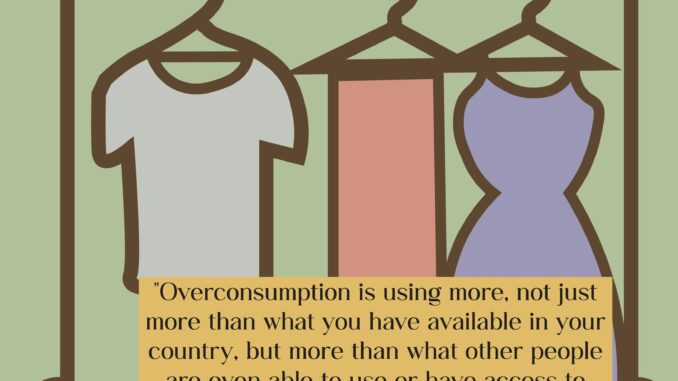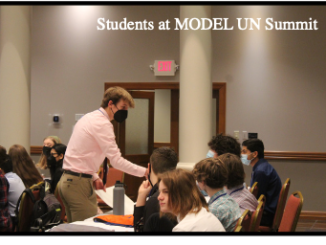
photo credit: Hiya Patel
Overconsumption has become the norm for Americans in recent decades. From consumer products such as makeup, food and fashion to everything as far as advertising, overindulgence is seeping its way into many aspects of American life.
Thinking of overconsumption often leads to brainstorming various food associations surrounding unhealthy eating habits, which is an understandable thought, as research reveals that less than three percent of Americans have a healthy lifestyle, according to Healthline.
The Centers for Disease Control and Prevention (CDC) researchers found that ultra-processed foods like soda and salty packaged snacks like potato chips can affect people’s cardiovascular health negatively. The No. 1 cause of death in the United States is heart disease, which kills about 610,000 Americans every year.
“There are some synthetically created trans fats, for instance, that are harmful; what you’ll sometimes see on food labels are partially hydrogenated soybean oil. What they do is they will hydrogenate, which means to shove extra hydrogens onto the fatty acids on soybeans; it improves shelf life but causes issues in the body in terms of being able to break those down, can increase arteriosclerosis and heart disease,” AP Biology Teacher Kevin Guse said.
According to the New World Report, the FDA takes a more reactive approach to food standards inspections. It allows food additives unless proven to be directly harmful. Europe, on the other hand, additives must be proven unharmful before they can be used in food production.
For instance, U.S. poultry suppliers wash chicken with chlorine to kill harmful bacteria that could be on the surface of the skin. In Europe, individual countries have different discretions on washing chicken with or without chemicals.
Consuming these toxins can be detrimental to one’s health, yet the human body does have processes it goes through to try to fight those toxins off.
“Many times, the body is very good at having backup mechanisms to make sure that harmful substances do not toxify our body,” Food and Nutrition instructor at Ohio University Jessica Arquette said. “So, if substances can get in our body, I would want people to know that just because something is natural, doesn’t mean that it is necessarily healthy for our body.”
According to the National Library of Medicine, advertisements, food influencer posts, cooking shows or peer-to-peer messages often promote unhealthy food norms by celebrating the overconsumption of non-core foods.
“There have been fad diets like the cabbage soup diet, the South Beach diet and Atkins; there are all of these quick fixes to try to put on pounds or take off pounds,” Guse said. “Unfortunately, you get a lot of enthusiasm around some diets that aren’t necessarily based on science. What I would recommend, if you’re considering a diet, talk to a trained professional like a dietitian or doctor. The problem comes when you don’t get the right balanced nutrients.”
Food is necessary to serve the purposes of nourishment and energization, but when unhealthily consumed, it can cause serious detriment. People must do their part in keeping their bodies healthy by eating well balanced meals.
Another commonly addressed issue associated with overconsumption is the problems surrounding fashion and clothing. In the world of modern retail, as trends grow, so does the amount of clothing people own. The rise of fast fashion caused by rapid production cycles and ever-changing trends has become an issue. According to Goodonyou, three out of five of 100 billion clothing garments will end up in landfill within a year of being produced.
Fast fashion can be described as cheap, trendy clothing that is designed, made and marketed at rapid speeds. The idea is to get the newest styles on the market as fast as possible, so shoppers can buy them while they are still at the height of their popularity and then discard them after a few wears, according to Goodonyou.
A few familiar brands that promote fast fashion are Shein, Cider, Zara, Hollister and H&M. Not only are clothes at these stores cheap, but also many customers have reported the items they bought are low quality and tend to be made out of weak materials.
But the reason these stores are able to get away with this isn’t because of their quality, but rather because they promise both style and affordability to their customers. And while that may sound great to many, there is a hidden cost that affects not just consumers’ wallets but also the environment and labor standards.
The low costs are typically achieved by exploiting cheap labor, especially in developing countries. Accidents, fires, injuries and disease are very frequent occurrences on textile production sites. Many of the workers for these stores endure poor conditions and minimal, if any, pay according to sustainyourstyle.com.
“Our clothes are made in a variety of countries, ranging from Vietnam to China. Once they are made, they are shipped to one of our many warehouses across the world and stored there until they are needed,” senior Hollister employee Sophia Kulesa said. “If they fail to sell at the outlets, then they are shipped, once again, back to a warehouse and put back into storage.”
According to the UN Environment Programme (UNEP), the fashion industry is the second-biggest consumer of water and is responsible for about 10 percent of global carbon emissions – more than all international flights and maritime shipping combined.
“I don’t doubt that the company’s method of creating, selling and storing these clothing items is bad. But, I am not sure there is much we, as employees, can do about that big of a problem. One thing our store does take pride in is our passdown program, where our clothes, that didn’t sell well, are passed down to our location at the Tanger Outlet mall in Sunbury,” Kulesa said.
Second hand stores, like Goodwill, and outlets, like Tanger, have been open for years.
“Our main goal is to take peoples’ donations and put them back on a rack to hopefully give the item another chance, essentially reducing waste and promoting sustainability,” Goodwill employee Amelia Henry said.
“I love second hand shopping,” senior Emily Campbell said. “Some people have found it to be gross and unhygienic, especially after COVID-19, but if it helps with the environment and allows me to get clothes for cheaper, then it’s a win-win.”
While getting cheaper clothes and helping the environment are both pros for many, second hand stores can only do so much. It is up to consumers to pull the rest of the weight.
One easy way to help achieve sustainability is by becoming more conscious of purchasing habits. Shifting toward sustainable brands that prioritize ethical production, investing in quality over quantity and embracing second hand shopping are just a few more small, yet important, steps that can have a big impact, according to goodonyou.
Social media can also play a role by promoting sustainable fashion and raising awareness about the importance of mindful consumption. Joining online local groups dedicated to sustainable fashion, such as “Upcycled clothing and Creations” on Facebook or “Upcycle Parts Shop” on Instagram, can also encourage shared learning and support.
In addition to these efforts, consumers can educate themselves about the lifecycle of their clothing, understand where materials come from and the labor practices behind production. As awareness grows and the conversation around sustainable fashion expands, empowering consumers to take a stand and demand change from the industry could have a positive impact on the world.
Another lesser known area of consumption is the cosmetic industry, such as makeup and beauty products. Whether it’s for a special occasion like a wedding or a simple outing with friends, makeup is used daily by millions of people around the world.
It’s estimated that in 2028 the revenue of the beauty and self-care market will be around $110.18 billion in the United States, according to Statista. This is almost $10 billion more than the expected revenue for 2024.
The cosmetics and self-care products bought only to be used maybe once or twice, end up being tossed in a landfill too along the wrappings of their packaging.
“I don’t buy makeup very often. The only times I have bought new makeup is if a specific eyeshadow was needed for a dance performance or I was adding an essential product to my full glam look,” junior Samira Kandhari said.
There is an estimated 120 billion units of trash each year, from all the wrappings and plastics of the packaging of cosmetics, according to Sustainable Earth.
“Overconsumption is using more, not just more than what you have available in your country, but more than what other people are even able to use or have access to in another country,” AP Environmental Teacher Jessica Timmons said.
Whether it’s from a friend or from a celebrity on social media, there is always some variable influencing someone to buy something like cosmetics and skincare.
“Overall, I would say TikTok influences me to buy a specific product. Seeing how products look on brown skin is very important to me and seeing good products on brown influencers is the easiest way to see if a product would look good on me,” Kandhari said.
With the rise of new beauty influencers encouraging fans to buy new products, the ingredients and the making of these goods can be unknown at times. There’s also the factor of products affecting people’s skin differently but being advertised as all skin types inclusive.
“There are lots of chemicals that are in makeup that aren’t used by themselves. All those chemicals together interact with you, your environment where you live, the food you eat, the other chemicals you are putting into your body or exposing yourself to. That’s called synergism and that’s where we end up seeing problems arise,” Timmons said, “Makeup has a lot of lead in it and part of the issue with our cosmetics, not just our food and drugs, is there’s just not enough people in the government to monitor what’s being put in our things that we consume.”
Along with the chemicals found in skincare and beauty products, there is a more global toll that can be caused by makeup as well.
“We don’t see all the negative environmental impacts that happen due to our acquisition of these things. We don’t think of how much oil was used to ship this stuff from country to country before it actually made it to the store,” Timmons said.
With the growing market of the beauty industry and the quickly involving products, it’s hard for consumers to resist the urge of buying a new item, especially when it seems like everyone is using and talking about the products.
“I always think through how much I will use a certain product to see if it would be worth it for me. I almost never wear a full face of makeup, so I don’t own a foundation and opt to use a skin tint,” Kandhari said.
Although items like cosmetics can be a fun expression and are a somewhat permanent fixture in culture today, it’s beneficial to know all the facts about them. One way to keep your consumption to a minimum would be to wait till your cosmetics and skin care products are mostly finished before looking out for new ones to buy. It’s important to know how to limit your own consumption of products, while also having a healthy balance of buying products you actually want.
Many tend to purchase products such as clothing and makeup because of influence from outside sources or advertising practices. Today, people are exposed to around 4,000 to 10,000 advertisements daily.
This is a huge contrast to the 1970s, when people saw around 500 to 1,600 per day, according to a study done by Media Dynamics. Many people think this surge in advertisements is normal, which leads society to believe that they need to buy more, causing overconsumption.
Advertisements have greatly evolved over the years, now often using various well-known personalities to encourage customers to buy products with catchy phrases and incentives. A major drawback to advertising going to social media is that it becomes difficult to know if an influencer is promoting a product or simply just showing their love for it.
“Now we see advertisements very differently online. How influences try to sell a product, but we don’t always know if it is an ad or not. People try to weave them into social media, so you don’t notice that it is an advertisement. The structure has changed but the message of this will make you more beautiful, or desirable or will make your life better in some way is still the same,” sociology teacher Leslie Hosgood said.
The mass number of advertisements seen today has impacted peoples’ psychology that can be either positive or negative. The message itself and how the message is delivered can greatly determine how a person feels about themselves.
“If advertisements that normalize something really empowering for people then advertisements can be great. But if the advertisements are normalizing people hating their bodies, then that could definitely be detrimental. I use the analogy that advertisements are like hammers. A hammer can be used for something really great, like building a house. A hammer can also be used to hurt someone, so advertisements can be used to push all kinds of messages or to normalize all kinds of messages,” Hosgood said.
The messages advertisements leave behind can be perceived in many ways and how we perceive them can be harmful to people’s mental health and the way they see themselves.
“Advertisements change the perspective that we have on ourselves as we see the standards in not only beauty but also products set by society and if we don’t have these, we see ourselves as inferior to those that do,” sophomore Sociology student Elizabeth Vranich said.
Several companies focus on emotional appeal in their advertising. Companies tend to use the insecurities of others to induce the pressure of wanting to look or be better according to Steven and Tate Marketing.
“I definitely think that advertisements cause people to feel pressure to follow the crowd by making them feel as though they need the item or service because everyone else has it,” Vranich said.
Advertisements not only affect psychology, but they also significantly affect the economy. Consumer spending is the foundation of the U.S. economy, covering over two-thirds of our nearly $28 trillion GDP. When consumers spend money on everyday goods and services, and make large purchases, it not only helps to increase economic growth but is also a reflection of economic trends, according to Brinkley Wealth Management.
“About 70 percent of economic activity is consumer spending. So, we need people to spend money to keep our economy going, and that’s what we’re kind of dependent on. There is an economic boost that comes from people spending money and buying products and how advertisements can influence people’s preferences,” Hosgood said.
Advertisements cause people to continue to over consume on products they would otherwise be fine without. Then, this overconsumption leads to an increase in economic waste that continues to destroy the environment according to Fordham University.
“On the flip side, though, we obviously have an economic cost to waste that piles up if people are constantly consuming. There’s waste generated and an economic cost to that too and a strain on the environment and resources,” Hosgood said.
This mass overconsumption scales across many different platforms and topics of American focus, creating a dramatically unhealthy intake in our culture. While there are ways to reduce these effects, the most important thing to remember is to pay attention to what you’re consuming, both physically and mentally.


